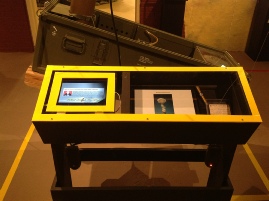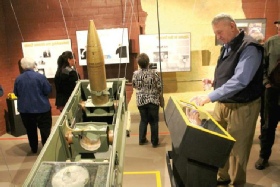

Building Kiosks from Tablets on a Shoe-
By Warren Martin on March 26, 2013 in Community, Interpretation
Few things are more daunting to a small museum director than walking through the halls of a major museum and seeing all the nifty gadgets they use. Kiosks galore! I found myself drooling with envy and wondering, “Is it possible to do something similar on a shoe-
The answer is yes!
Tablet-
We first called the techies and asked them for a basic IT solution to increase audience participation. With their quote of $38,000, though, the project was dead, but not the dream.
I spent months pondering the big questions:
How can I increase audience participation?
How can I enhance communication and interactive dialog?
Why the heck does it cost so much????
Then it hit me. We’re approaching the issue backwards. It’s not about the technology; it’s about the knowledge!
Our team began developing kiosks for under $600 to revolutionize our visitor’s museum experience. With each we use KIOSK, an acronym beginning and ending with the word “knowledge.”
KNOWLEDGE of your audience. Will a kiosk enhance audience experience or detract from it? Depending on the age and demographics of your audience, a kiosk can be either a tremendous asset or a complete waste of time. Our older visitors usually have little interest in them. We have very active educational programming that regularl y brings large groups of students through the museum. These kiosks tend to break up large group tours and provide small group interactive modules for students.
y brings large groups of students through the museum. These kiosks tend to break up large group tours and provide small group interactive modules for students.
INSTALLATION in exhibitions. We wanted the kiosks to add to – not detract from – the exhibition. By focusing on the artifacts, rather than on the technology, we reduced the cost considerably.
OPERATION of the kiosk. If you can’t operate the kiosk, then you’ve wasted your time. We keep the page designs simple. No page has more than four choices on it. Most only have two: back and next.
SUSTAINABILITY of the piece. If you can’t give it to a three-
KNOWLEDGE communicated to your audience. The point of adding a kiosk is to communicate the content of the exhibition more effectively. It’s easy to get sidetracked by trying to get the graphics perfect and adding all kinds of “frou-
Once we took this approach, we realized how much money the kiosks saved us. We didn’t have to print, mount and install new information boards, and the boards didn’t need as much content.
Our most expensive kiosk installation cost $820. Our cheapest (with a donated tablet) was $225. The average cost of installing each kiosk was $589.
How Can You Build a Kiosk from a Tablet? Part 2
By Warren Martin on March 28, 2013 in Community, Interpretation
We wanted to create an interactive system for less than $750 per kiosk. By using tablets, we reduced the cost to less than $600. The key to success is to know your audience, your exhibit’s content, and the technology you use.
The iPad works for us, but use what you know. There’s no sense saving $50 on a tablet, if you spend hundreds of dollars training someone how to use it.
We used the cheapest iPad2 on the market. It has wi-
them only when they’re on sale.
We have also let people in our community know that we are looking for this model. When they upgrade, we encourage them to donate their old model to us.
The tablet will only store a basic website with content, so it doesn’t need 64GB of memory. We’ve put videos, photos, timelines and other kinds of content on our kiosks without using half the memory on a single one.
You can buy the Kiosk Pro Plus app for $39.95 and install it on up to five devices. Other tablets might require another brand of app, but there are comparable apps on the market (such as SureLock for Android). Kiosk Pro is user-
Developing the tablet’s content requires slightly higher levels of technological expertise. You may only want to install a loop movie or a PDF. From our experience, self- r back. We use Dreamweaver, but again, use what you know. The simpler the design, the more interaction occurs. If users waste time figuring out what to do next, you lose them. Keep it simple.
r back. We use Dreamweaver, but again, use what you know. The simpler the design, the more interaction occurs. If users waste time figuring out what to do next, you lose them. Keep it simple.
Finally, to get the content onto the tablet, install a program (e.g., DiskAid) onto your computer. This program lets you access your tablet through the back door and upload your content directly into the Kiosk Pro app. Once it’s uploaded, designate the index file for the content (home page).
Turning a tablet into a kiosk may require some technological knowledge, but that’s okay. Stick to familiar machines and programs. To make life easier, use the same program for developing your website and kiosk.
In our next blog, we’ll discuss how to install your tablet so it doesn’t take away anything from the exhibition.
Warren Martin, Executive Director of the General Tommy Franks Leadership Institute and Museum, is the primary presenter of all Inspired Leadership Experiences. Warren has been leading leadership workshops, presenting keynote presentations and consulting with Fortune 500 corporations for 16 years. A Philosophy graduate from Texas Tech and author of 5 books, Warren is known for his unique teaching style. He has worked in 28 countries around the world (mostly in the Middle East and Latin America). He has also worked with teachers, organizations, and youth ministers to develop curriculum and need specific training. Warren has been listed among the top 400 speakers in America. His passion is to invest in the lives of others through servant leadership to assist them in reaching their full potential.
Kiosks
Kiosks Should Add, Not Distract. Part 3

By Warren Martin on April 3, 2013 in Community, Interpretation
How can you install an interactive display without it taking away from the exhibition? After all, it’s about the content, not the equipment. We wanted to incorporate each kiosk into an exhibition to heighten mood and focus on the content simultaneously.
You certainly don’t have to create an elaborate display to install an interactive tablet. Many companies sell tablet display cases to use as a kiosk. The most durable, child-
So we had to get creative.
Vietnam War kiosk display case modeled after ammunition boxes.
We began once again with the content. What would enhance the mood of each exhibition? For an exhibit on the Vietnam War, we built a display case modeled after ammunition boxes used during that period. Our Korean War exhibit had a tablet built into a Korean garden gate. For our Cold War display, a control panel stands next to our W-
Again, stick with what you know. We could have used metal, but some team members are talented woodworkers, so we made our cases out of that instead.
Make sure visitors can interact with the screen without operating the control buttons, other than to exit the kiosk app.
Tablet built into a Korean garden gate at the Gen. Tommy Franks Museum
If your display has a video or audio component, what kind of speaker system will you use? For us, the best system is also the cheapest. We install $15 Logitech computer speakers with a built-
If we notice a visitor avoiding the kiosk, a docent strikes up a conversation and walks them through the content. This makes them more likely to use other kiosks throughout the museum.
As we’ve said throughout this series, an exhibit is only as good as its content. Interactive displays should enhance, not overwhelm, the experience. Stick to what you know about your audience and about your museum’s content, and you’ll develop a kiosk system that enhances your museum.
Warren Martin, Executive Director of the General Tommy Franks Leadership Institute and Museum, is the primary presenter of all Inspired Leadership Experiences. Warren has been leading leadership workshops, presenting keynote presentations and consulting with Fortune 500 corporations for 16 years. A Philosophy graduate from Texas Tech and author of 5 books, Warren is known for his unique teaching style. He has worked in 28 countries around the world (mostly in the Middle East and Latin America). He has also worked with teachers, organizations, and youth ministers to develop curriculum and need specific training. Warren has been listed among the top 400 speakers in America. His passion is to invest in the lives of others through servant leadership to assist them in reaching their full potential. Read Part I and Part II of this series to understand Warren’s approach to kiosks.